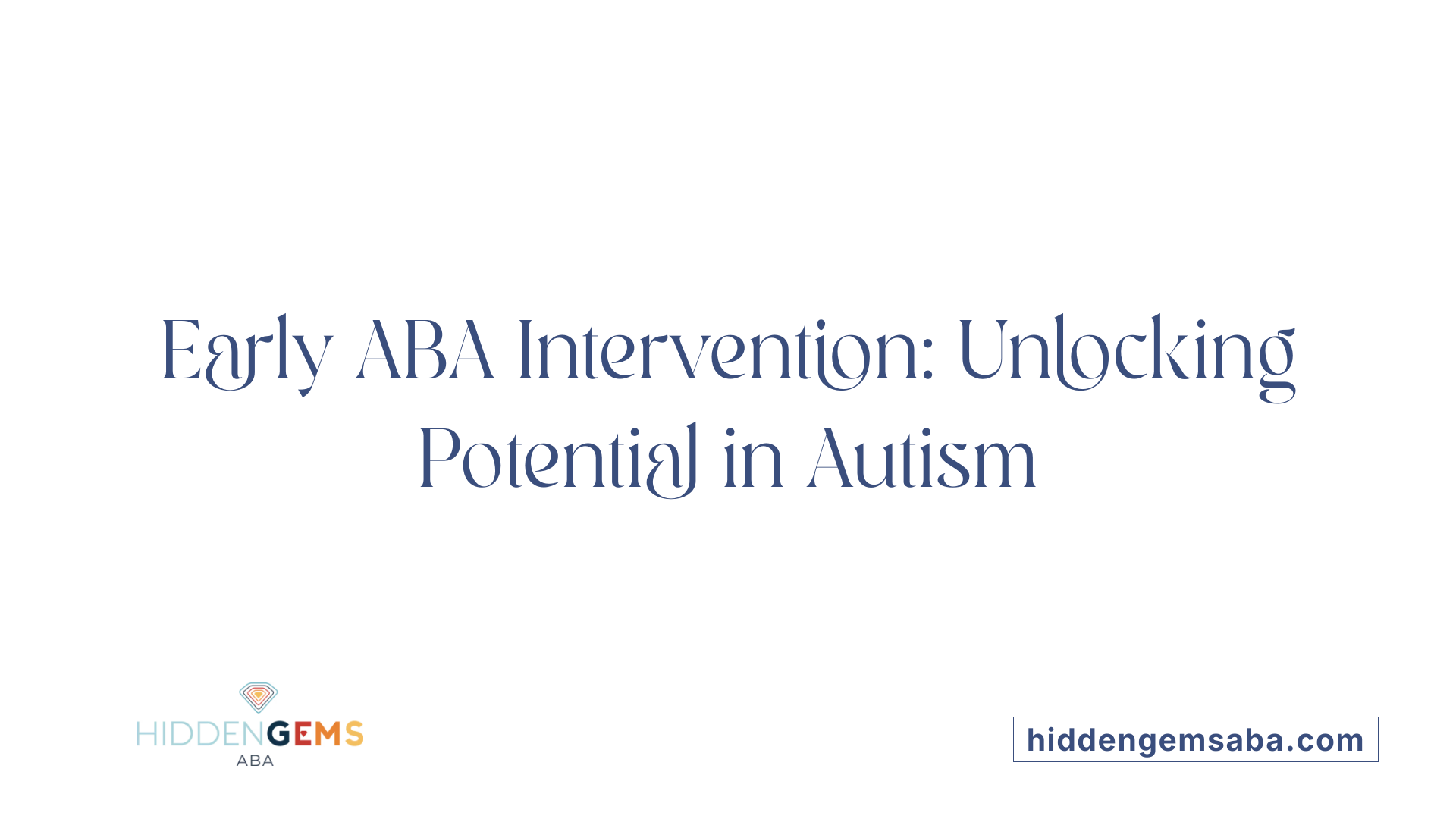Understanding the Pathway to Independence
Transitioning from childhood to adulthood can be particularly challenging for individuals with autism spectrum disorder (ASD). Applied Behavior Analysis (ABA) therapy emerges as a scientifically grounded approach that equips children with autism with essential skills to navigate this critical life stage successfully. This article delves into autism characteristics, the fundamentals of ABA therapy, and how this intervention supports children as they grow towards independence in adulthood.
What is Autism and How is it Characterized?

Definition and Core Characteristics of Autism
Autism, also known as autism spectrum disorder (ASD), is a lifelong neurological and developmental condition. It primarily affects how an individual interacts socially, communicates, learns, and behaves. Autism typically becomes apparent in early childhood, often by ages two or three. The symptoms and severity can vary widely among individuals, creating a "spectrum" of experiences.
Common traits of autism include challenges in social skills, difficulty interpreting nonverbal cues like gestures and facial expressions, repetitive behaviors, restricted or intense interests, and heightened sensory sensitivities. These differences influence how people with autism perceive and respond to the world around them.
Common Challenges Faced by Individuals with Autism
People with autism often find social interaction and communication more challenging than neurotypical individuals. For example, they may struggle with starting or maintaining conversations or understanding social rules that others find intuitive. These social challenges can sometimes lead to feelings of isolation or misunderstanding.
Repetitive behaviors or strict routines provide predictability and comfort but can cause difficulty when changes occur. Sensory sensitivities may make certain sounds, textures, or lights overwhelming, which can impact participation in everyday activities.
Early Diagnosis and Impact of Tailored Interventions
Early diagnosis of autism is crucial as it enables timely and tailored intervention strategies. Behavioral therapies like Applied Behavior Analysis (ABA) target foundational skills such as communication and social interaction. Early intervention, often intensive and lasting for many hours per week, has been associated with improved language use, social skills, and adaptive behaviors.
Providing personalized support during a child's developmental window enhances their ability to navigate social settings and participate actively in educational environments. Along with specialized therapies, involving caregivers and educators ensures that gains made during therapy generalize to home and school.
In summary, autism is a diverse condition marked by challenges and unique strengths. Early, individualized support can significantly improve life skills, social competence, and independence for children on the autism spectrum.
Foundations of ABA Therapy: Principles and Practices

What is applied behavior analysis (ABA) therapy?
Applied Behavior Analysis (ABA) therapy is a scientifically validated approach that systematically analyzes and modifies behavior using learning principles. Its primary goal is to increase helpful behaviors like communication, social skills, and daily living abilities, while reducing harmful or disruptive behaviors in individuals with autism.
ABA therapy is tailored to each individual through careful assessment and goal setting. Treatment plans often use techniques such as positive reinforcement, prompting, Discrete Trial Training, Pivotal Response Treatment, and Natural Environment Teaching. This personalized approach ensures that interventions match the child’s unique strengths and challenges.
What are the key techniques and treatment modalities?
ABA employs structured, one-on-one teaching with repeated practice and immediate feedback. Key strategies include:
- Positive Reinforcement: Rewarding desired behaviors to encourage repetition.
- Prompting and Fading: Giving support cues which are gradually removed to encourage independence.
- Functional Behavior Assessments: Identifying reasons behind challenging behaviors and replacing them with positive alternatives.
- Skill Generalization: Practicing learned skills across various settings like home, school, and community to promote real-life use.
These techniques work together to build skills such as speech, social interaction, self-care, and emotional regulation.
Role of behavior analysts and interdisciplinary teams
Licensed behavior analysts oversee the ABA therapy process. They conduct assessments, develop individualized treatment plans, and monitor progress using data-driven methods. They collaborate with educators, speech therapists, occupational therapists, vocational specialists, and families to ensure comprehensive support.
Family involvement is a crucial part of ABA treatment. Parents receive training to apply ABA techniques consistently, which maximizes learning opportunities outside therapy sessions. This partnership helps maintain and extend gains.
Through interdisciplinary collaboration and evidence-based practices, ABA therapy supports individuals with autism in reaching their full potential and improving quality of life.
Early Intervention: Timing and Impact of ABA on Autism Outcomes

At what age can ABA therapy be started for children with autism?
ABA therapy can be initiated at any age for children with autism, but it proves most effective when begun early, ideally between ages 2 and 5. Starting therapy during these key developmental years capitalizes on the brain's plasticity, enabling improvements in communication, social skills, and behavior. Early intervention before age 4 is linked to better long-term outcomes, such as increased IQ and enhanced skill growth. Even children under 18 months have shown progress with early ABA, including advancements in language and attention.
What are the benefits of early and intensive intervention?
Early and intensive ABA involves up to 40 hours per week over multiple years, allowing consistent teaching and reinforcement. This consistent approach helps build essential skills in communication, social interaction, and daily living. It also reduces challenging behaviors like aggression and self-injury by replacing them with positive alternatives. Moreover, parents actively participate throughout the therapy, fostering skill generalization at home and reducing future service needs.
How does early ABA treatment impact progression and long-term gains?
Children receiving early ABA often experience significant gains, including the ability to return to mainstream classrooms. The therapy breaks complex skills into manageable steps, improving language, self-care, and social competence. As skills develop, children become more independent and better equipped to engage in their communities. While improvements vary individually, early ABA sets a foundation for lifelong learning, social adaptation, and potential independence.
| Aspect | Details | Impact |
|---|---|---|
| Optimal Starting Age | Early childhood (2-5 years), benefits seen even under 18 months | Greater neuroplasticity leads to enhanced skill acquisition |
| Intervention Intensity | Up to 40 hours/week over years | Intensive practice reinforces learning and behavior change |
| Skills Developed | Communication, social interaction, self-care, behavior management | Improved independence and quality of life |
| Parent Involvement | Active collaboration and training | Helps generalize skills outside therapy, reducing future needs |
| Long-Term Benefits | Mainstream classroom participation, social competence, independence | Supports lifelong success and community inclusion |
ABA Therapy's Role in Developing Core Life Skills for Independence
What are some common goals targeted in ABA therapy for autism?
ABA therapy aims to enhance several important skills in children with autism, creating a foundation for independence. Communication goals focus on enabling children to request items, label objects, and participate in social exchanges. Therapists work on receptive language too, helping children follow directions and understand vocabulary.
Skill areas targeted: communication, social, daily living, and emotional regulation
ABA targets key life skills across multiple areas. Communication development includes verbal speech, sign language, or use of communication devices, which helps children express needs effectively. Social skills training helps children recognize emotions, greet others, share, take turns, initiate conversations, and resolve conflicts.
Daily living skills are another primary focus. These include toileting, dressing, feeding, showering, hand washing, meal planning, budgeting, and personal hygiene. Mastering these skills fosters self-reliance and confidence. Emotional regulation is also addressed, where children learn self-control and strategies to manage emotions such as anxiety or frustration.
Use of individualized plans and SMART goals
ABA therapy involves individualized assessment of each child’s strengths and challenges, followed by tailored intervention plans. These are often built around SMART goals—specific, measurable, achievable, relevant, and time-bound objectives—to track progress effectively. Therapists collect data regularly, monitor improvements, and adjust plans to ensure targeted skill development.
The approach ensures that interventions match the child’s unique needs, helping them generalize skills in different settings like home, school, and community. By focusing on meaningful and practical outcomes, ABA therapy supports children with autism in gaining the skills needed for greater independence and improved quality of life.
Supporting Transition to Work: Employment and Vocational Skills Through ABA

How does ABA support workplace communication and social skills?
ABA therapy teaches essential workplace communication skills such as active listening, interpreting social cues, and following instructions. These skills enable individuals with autism to express their needs clearly, collaborate effectively, and build relationships with coworkers. Social skills training through ABA also focuses on initiating conversations, making friends, and resolving conflicts, contributing to a more confident presence in the workplace.
How does ABA help manage workplace challenges like anxiety and sensory sensitivities?
ABA interventions include strategies to manage anxiety and sensory sensitivities that can arise in workplace settings. Techniques involve behavioral approaches to reduce stress responses and gradually adapt individuals to changes in routines or environments. This individualized support helps employees with autism maintain focus and cope with potential sensory overloads or unexpected workplace demands.
In what ways does ABA collaborate with employers and vocational specialists for job success?
ABA professionals work closely with vocational specialists, job coaches, and employers to tailor interventions based on the individual's strengths and challenges. Collaboration often includes providing autism awareness training to employers and recommending workplace modifications to enhance comfort and productivity. Additionally, ABA promotes role-playing and practice across different work environments to ensure skills generalize effectively. Long-term monitoring and support are maintained to sustain employment success and ongoing adaptation.
Family Involvement and Long-Term Support in ABA Therapy
How Are Parents and Caregivers Trained in ABA Techniques?
Parents and caregivers play a central role in the success of ABA therapy. They receive training in specific ABA strategies that guide them on how to respond constructively to their child's behaviors. This training empowers families to create consistent learning environments and reinforces skill development throughout daily routines. By mastering prompting, reinforcement, and communication techniques, caregivers can maximize their child's progress beyond therapy sessions.
How Does Family Involvement Help Reduce Parental Stress?
Involvement in ABA therapy reduces parental stress by giving caregivers tools to understand and manage challenging behaviors effectively. Knowing they can support their child's development increases confidence and decreases anxiety. Families also benefit from a collaborative approach where therapists provide ongoing coaching and emotional support, fostering a positive home environment that supports the child's growth and well-being.
Why Is Long-Term Monitoring Important in ABA Therapy?
ABA therapy includes long-term monitoring to ensure that skills learned generalize across settings and are maintained as the child grows into adolescence and adulthood. This ongoing assessment allows for adaptation of treatment goals to address new challenges, such as education, employment, and independent living skills. Continuous support helps individuals with autism sustain their progress and promotes lifelong success.
Who Typically Provides ABA Therapy Services?
ABA therapy is typically delivered by licensed professionals such as Board Certified Behavior Analysts (BCBAs) with advanced psychology or behavior analysis degrees. BCBAs supervise therapists and registered behavior technicians (RBTs) who implement individualized treatment plans. Services can take place in homes, schools, or community settings, with a strong emphasis on the provider's credentials to ensure effective outcomes.
| Aspect | Details | Importance |
|---|---|---|
| Parent Training | Teaches ABA strategies for consistent support | Enhances skill generalization and family empowerment |
| Stress Reduction | Reduces anxiety through increased understanding and tools | Improves family well-being and treatment adherence |
| Long-Term Monitoring | Ongoing skill assessment and goal adaptation | Supports progress through life transitions |
| Providers | BCBAs and trained therapists delivering tailored therapy | Ensures quality and individualized interventions |
Navigating Controversies and Ethical Considerations in ABA Therapy
Are there any controversies or criticisms associated with ABA therapy?
Applied Behavior Analysis (ABA) therapy has faced several criticisms over time. Some argue that it can be rigid and repetitive, potentially causing emotional distress to children undergoing treatment. Early use of aversive methods, such as electric shocks, although now discredited and abandoned, has left a lasting concern about the safety and ethics of behavior interventions.
Critics also highlight that ABA may encourage children to mask or suppress their natural autistic traits. This masking can lead to feelings of identity loss, increased anxiety, and burnout. Many autistic self-advocates feel that ABA sometimes focuses too heavily on eliminating behaviors deemed undesirable rather than supporting emotional needs or promoting self-understanding.
Historical use of aversive methods and modern practices
Historically, ABA included some harsh techniques aimed at stopping harmful behaviors. These approaches have been replaced by positive reinforcement and more naturalistic strategies. Today, ABA emphasizes individualized, respectful, and compassionate methods designed to boost communication, social skills, and independence without causing harm.
Balancing behavioral goals with neurodiversity and emotional well-being
Modern ABA therapy strives to respect neurodiversity by recognizing and valuing the unique experiences of autistic individuals. Therapists work to balance skill-building with fostering emotional well-being instead of merely targeting behavior suppression. Involving families, using positive reinforcement, and tailoring goals collaboratively help ensure that therapy supports a child's overall quality of life.
Ongoing ethical debates encourage continuous reflection and improvement within the ABA community to develop approaches that empower individuals with autism while minimizing any potential harm.
The Path Forward: ABA Therapy as a Bridge to Adult Independence
Applied Behavior Analysis therapy offers a comprehensive, evidence-based framework to support children with autism as they transition into adulthood. Through early intervention, personalized goal setting, and the development of communication, social, vocational, and life skills, ABA helps individuals build confidence and functionality for greater independence. Family involvement and professional collaboration further reinforce progress, while awareness of ethical considerations ensures therapy remains respectful and empowering. By embracing ABA's evolving practices, families and practitioners can foster meaningful opportunities for individuals with autism to thrive and contribute fully in adult life.
References
- Autism Treatment and Transition to Adulthood
- The Top 10 Reasons Children With Autism Deserve ABA
- The Role of ABA in Transitioning Young Adults with Autism
- ABA Therapy for Adolescents and Young Adults with Autism
- 6 Life-Changing Benefits of ABA Therapy for Children ... - Linx
- 7 Surprising Benefits of ABA Therapy for Kids You Need to ...
- Applied Behavior Analysis (ABA)
- Choosing an ABA Therapy Provider
- Applied Behavior Analysis (ABA)
- Applied Behavior Analysis (ABA)





